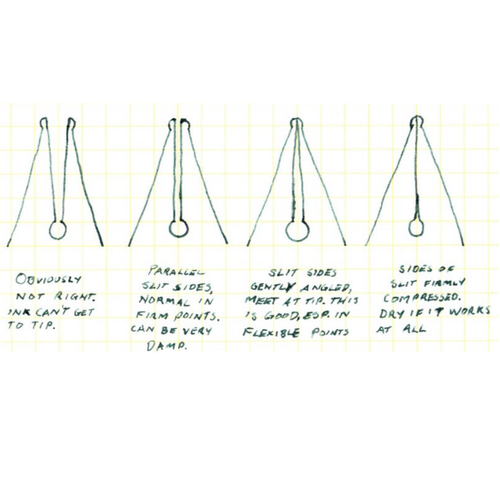When you draw with a large flexible dip nib in a fountain pen, we recommend that you use an overfeed. Dip nibs lack a fundamental design feature that is present in all good fountain pen nibs, and an overfeed helps compensate for the missing feature.
The missing feature is a beveled ink channel running from the air hole to the tip of the nib. The figure below shows four possible configurations.

Photo: Adjusting fountain pen tines
The ideal configuration for fountain pen nibs is the third from the left where the channel narrows as it approaches the tip. If you have a fountain pen, hold it up to the light so the shines through the ink channel, and you should see what I’m talking about.
The channel draws the ink from the vent to the tip through capillary action. The channel has to narrow because capillary action draws liquid in the direction of narrowing sides. If the channel doesn’t narrow, or narrows in the wrong direction, the ink will not flow correctly to the tip. This provides a steady flow of ink to the tip and prevents ink from spilling onto and disfiguring the surface of the nib.
A dip nib uses the configuration shown above on the right, just two sides butt snug against each other. There is no open channel, so there is no room for the ink to flow in any direction. A dip nib is not designed to feed ink to the tip of the nib. It is designed to hold ink on the surface of the nib through surface tension and feed ink to the tip through gravity flow.
When you stick a dip nib into a fountain pen, the ink has a hard time getting to the tip. You can shake the pen to flood the surface of the nib with ink, and the ink will collect at the tip, but you won’t be able to draw that way.
That’s why you need an overfeed. The overfeed takes the ink that flows out from the vent and holds it on the top of the nib while the ink flows to the tip. When the nib flexes off the bottom feed, the overfeed continues to feed ink to the tip and sustains the flow of ink. It isn’t a perfect solution, but it’s as close as you can get with inexpensive dip nibs.
Cheers and Happy Scribbling!



